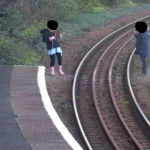Network Rail and British Transport Police are urging the public remember the importance of rail safety this April.
Their warning came after newly released stats revealed that the number of trespass incidents on the railway network increases by 25 per cent during the month of April, as the clocks go forward to mark the start of British Summer.
Network Rail added that trespass is a major problem on the railway, with around 19,000 recorded incidents each year – almost one for every mile of track in the country. Figures show that the number of incidents significantly increases between the months of March and April every year, coinciding with children’s school Easter holiday break and the onset of British Summer Time. Concerningly, the surge in incidents is even greater among children, with last year seeing a 40 per cent increase in incidents involving young people under the age of 18 years. Nearly two-thirds of all trespass incidents take place during the official summer months of April through to October.
Louise McNally, Trespass Prevention Lead at Network Rail, said: “These are shocking figures. Longer days and warmer weather should not be an excuse for people to behave irresponsibly around the railway when it can be a dangerous place if not used correctly. Trespassing can result in devastating consequences that affect us all – from life-changing injuries for individuals and their families, through to delays to passenger journeys. No one wants to see anyone come to harm. We urge people to ensure that they and their loved ones know how to use the railway safely so that we can all enjoy the joys of rail travel this British Summertime.”
Network Rail and British Transport Police run the You vs Train campaign, which aims to educate the public of the dangers present on the railway to deter them from trespassing and keep them safe from harm. Key rail facts that it teaches include:
Trains can travel at speeds up to 125mph. If the brakes are applied, it can take the length of 20 football pitches for a train to come to a complete stop.
The electricity used to power the railway – 25,000 volts in the overhead cables and 750 volts in the third rail – is on 24 hours a day, seven days a week.
You don’t have to touch the electricity sources on the railway to be at risk of harm. Electricity can jump and arc.
To learn more about the You vs Train campaign and key rail safety facts visit www.youvstrain.co.uk. Materials suitable for teaching younger children about rail safety in an age-appropriate way can be found on the Switched On website: Home – Switched On! (switchedonrailsafety.co.uk)

